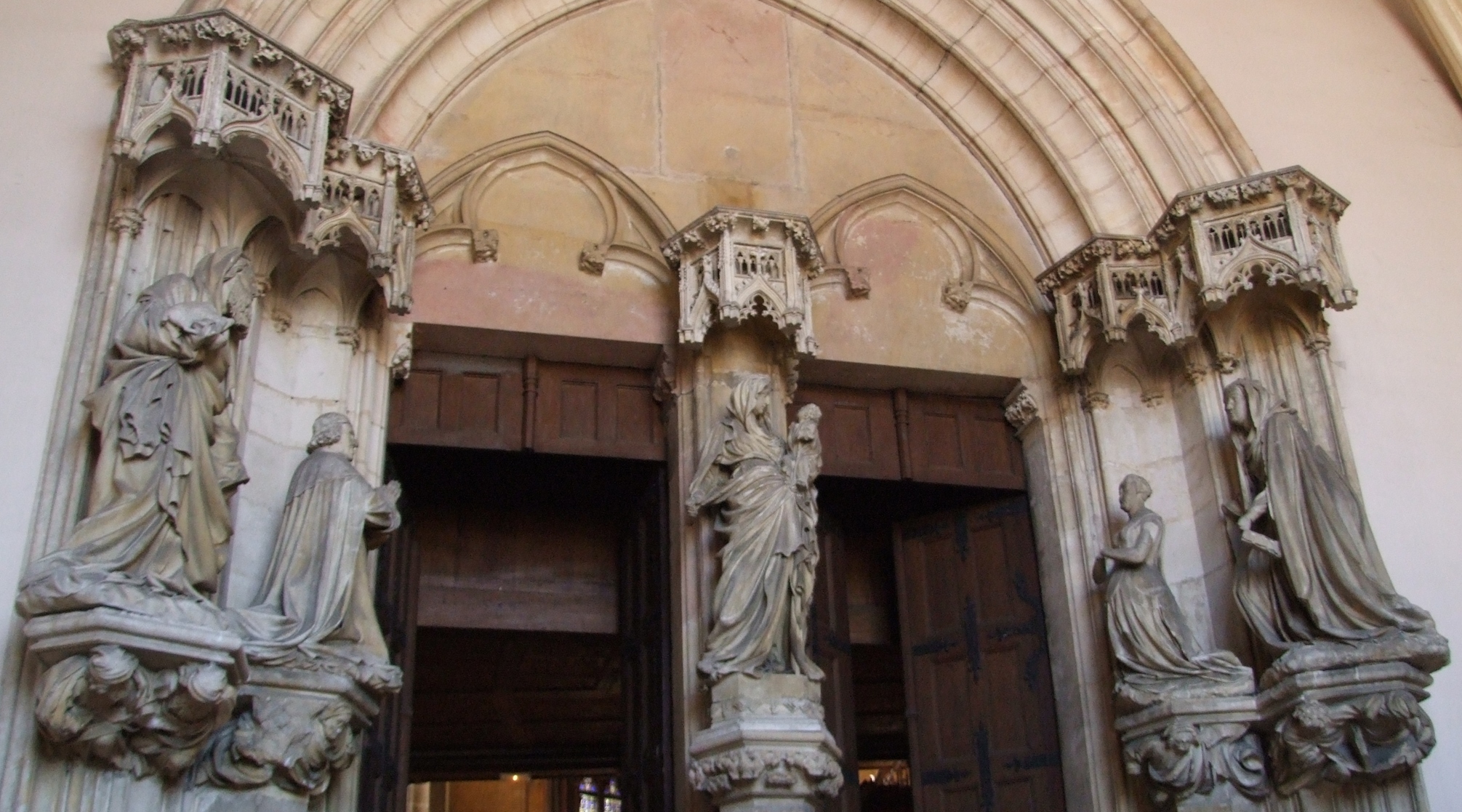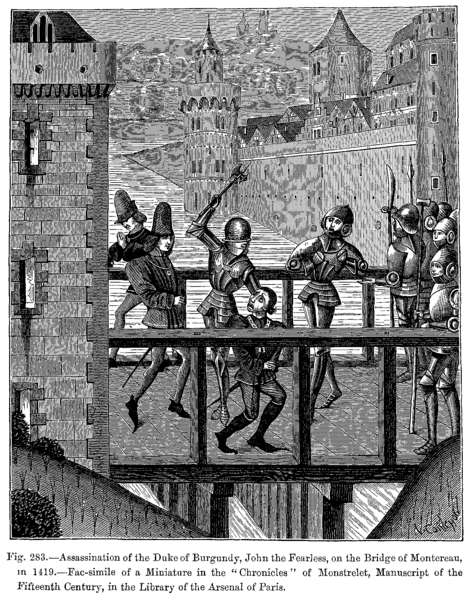|
Antoine Le Moiturier
Antoine Le Moiturier (1425–1495) was a French sculptor. He was born in Avignon into a family of sculptors. His uncle was the itinerant French master Jacques Morel. Following from the work of Jean de la Huerta beginning in 1443, Le Moiturier completed a group of sculptures of Pleurants known as the Mourners of Dijon. Completed in 1470, these sculptures are in the architectural frieze on the tombs of Duke John the Fearless and Margaret of Bavaria. They reside at the Palace of the Dukes of Burgundy in Dijon. The job had originally been assigned to the workshop of Claus Sluter, but went to Le Moiturier and De la Huerta. In 1461, le Moiturier was hired by Canon Jacques Oboli to create an altarpiece for St Pierre, Avignon. Oboli died before the work could be completed, and in 1463 the church commissioned an altarpiece depicting the Last Judgement. le Moiturier completed this two years later. This stellar work included statues of Jesus, Saint Peter and Paul, and several angel ... [...More Info...] [...Related Items...] OR: [Wikipedia] [Google] [Baidu] |
Dijon
Dijon (, , ) (dated) * it, Digione * la, Diviō or * lmo, Digion is the prefecture of the Côte-d'Or department and of the Bourgogne-Franche-Comté region in northeastern France. the commune had a population of 156,920. The earliest archaeological finds within the city limits of Dijon date to the Neolithic period. Dijon later became a Roman settlement named ''Divio'', located on the road between Lyon and Paris. The province was home to the Dukes of Burgundy from the early 11th until the late 15th centuries, and Dijon became a place of tremendous wealth and power, one of the great European centres of art, learning, and science. The city has retained varied architectural styles from many of the main periods of the past millennium, including Capetian, Gothic, and Renaissance. Many still-inhabited town-houses in the city's central district date from the 18th century and earlier. Dijon's architecture is distinguished by, among other things, '' toits bourguignons'' (Burgu ... [...More Info...] [...Related Items...] OR: [Wikipedia] [Google] [Baidu] |
Artists From Avignon
An artist is a person engaged in an activity related to creating art, practicing the arts, or demonstrating an art. The common usage in both everyday speech and academic discourse refers to a practitioner in the visual arts only. However, the term is also often used in the entertainment business, especially in a business context, for musicians and other performers (although less often for actors). "Artiste" (French for artist) is a variant used in English in this context, but this use has become rare. Use of the term "artist" to describe writers is valid, but less common, and mostly restricted to contexts like used in criticism. Dictionary definitions The ''Oxford English Dictionary'' defines the older broad meanings of the term "artist": * A learned person or Master of Arts. * One who pursues a practical science, traditionally medicine, astrology, alchemy, chemistry. * A follower of a pursuit in which skill comes by study or practice. * A follower of a manual art, such a ... [...More Info...] [...Related Items...] OR: [Wikipedia] [Google] [Baidu] |
1495 Deaths
Year 1495 ( MCDXCV) was a common year starting on Thursday (link will display the full calendar) of the Julian calendar. Events January–December * February – King's College, Aberdeen, predecessor of the University of Aberdeen in Scotland, is founded on the petition of William Elphinstone, Bishop of Aberdeen. It is the first English-speaking university to teach medicine. * February 22 – Italian War of 1494–98: King Charles VIII of France enters Naples, to claim the city's throne. A few months later, he decides to return to France, and leaves Naples with most of his army, leaving a force under his cousin Gilbert, Count of Montpensier as viceroy. Syphilis is first definitely recorded in Europe during this invasion. (perhaps from French forces who may have contacted Croats fleeing an Ottoman army in the east). * May 26 – A Spanish army under Gonzalo Fernández de Córdoba lands in Calabria, with the purpose of ousting the French and restoring Ferdinand ... [...More Info...] [...Related Items...] OR: [Wikipedia] [Google] [Baidu] |
1425 Births
Fourteen or 14 may refer to: * 14 (number), the natural number following 13 and preceding 15 * one of the years 14 BC, AD 14, 1914, 2014 Music * 14th (band), a British electronic music duo * ''14'' (David Garrett album), 2013 *''14'', an unreleased album by Charli XCX * "14" (song), 2007, from ''Courage'' by Paula Cole Other uses * ''Fourteen'' (film), a 2019 American film directed by Dan Sallitt * ''Fourteen'' (play), a 1919 play by Alice Gerstenberg * ''Fourteen'' (manga), a 1990 manga series by Kazuo Umezu * ''14'' (novel), a 2013 science fiction novel by Peter Clines * ''The 14'', a 1973 British drama film directed by David Hemmings * Fourteen, West Virginia, United States, an unincorporated community * Lot Fourteen, redevelopment site in Adelaide, South Australia, previously occupied by the Royal Adelaide Hospital * "The Fourteen", a nickname for NASA Astronaut Group 3 * Fourteen Words, a phrase used by white supremacists and Nazis See also * 1/4 (other) * ... [...More Info...] [...Related Items...] OR: [Wikipedia] [Google] [Baidu] |
Tomb Of Philippe Pot
The tomb of Philippe Pot is a life-sized funerary monument commissioned by the military leader and diplomat Philippe Pot for his burial at the chapel of Saint-Jean-Baptiste in Cîteaux Abbey, Dijon, France. His effigy shows him recumbent on a slab, his hands raised in prayer, and wearing armour and a heraldic tunic. The eight mourners () are dressed in black hoods, and act as pallbearers carrying him towards his grave. Pot commissioned the tomb when he was around 52 years old, some 13 years before his death in 1493. The detailed inscriptions written on the sides of the slab emphasise his achievements and social standing. Pot was a godson of Philip the Good and became a knight of the Golden Fleece. He served under two of the last Valois Dukes of Burgundy, Philip the Good and Charles the Bold. After the latter's defeat by René II, Duke of Lorraine, at the battle of Nancy in 1477, Pot switched allegiance to the French king, Louis XI, who eventually appointed him grand seneschal of ... [...More Info...] [...Related Items...] OR: [Wikipedia] [Google] [Baidu] |
Pleurants
Pleurants or weepers (the English meaning of ''pleurants'') are anonymous sculpted figures representing mourners, used to decorate elaborate tomb monuments, mostly in the late Middle Ages in Western Europe. Typically they are relatively small, and a group were placed around the sides of a raised tomb monument, perhaps interspersed with armorial decoration, or carrying shields with this. They may be in relief or free-standing. In English usage the term "weepers" is sometimes extended to cover the small figures of the deceased's children often seen kneeling underneath the tomb effigy in Tudor tomb monuments. These figures represent the mourners, who pray for the deceased standing during the funeral procession.Stone, 146 Because many of the original tombs have been vandalised or destroyed, relatively few examples remain to be studied. Many figures have been detached from their original context, which is not always known. In the 16th and 17th century the practice of placing anon ... [...More Info...] [...Related Items...] OR: [Wikipedia] [Google] [Baidu] |
Claus Sluter
Claus Sluter (1340s in Haarlem – 1405 or 1406 in Dijon) was a Dutch sculptor, living in the Duchy of Burgundy from about 1380. He was the most important northern European sculptor of his age and is considered a pioneer of the "northern realism" of the Early Netherlandish painting that came into full flower with the work of Jan van Eyck and others in the next generation. Life The name "Claes de Slutere van Herlam" is inscribed in the Register of the Corporation of Stonemasons and Sculptors of Brussels around the years 1379/1380. He then moved to the Burgundian capital of Dijon, where from 1385 to 1389 he was the assistant of Jean de Marville, court sculptor to Philip the Bold, Duke of Burgundy. From 1389 to his death he was court sculptor himself, with the rank of ''valet de chambre''. He was succeeded by his nephew Claus de Werve. Work Sluter's most significant work is the so-called ''Well of Moses'' (1395–1403), or the Great Cross. It was created for the Carthusian monast ... [...More Info...] [...Related Items...] OR: [Wikipedia] [Google] [Baidu] |
Palace Of The Dukes Of Burgundy
The Palace of the Dukes and Estates of Burgundy or ''Palais des ducs et des États de Bourgogne'' is a remarkably well-preserved architectural assemblage in Dijon. The oldest part is the 14th and 15th century Gothic ducal palace and seat of the Dukes of Burgundy, made up of a logis still visible on place de la Liberation, the ducal kitchens on cour de Bar, the tour de Philippe le Bon, a "guette" overlooking the whole city, and tour de Bar. Most of what can be seen today, however, was built in the 17th and especially the 18th centuries, in a classical style, when the palace was a royal residence building and housed the estates of Burgundy. Finally, the 19th façade of the musée on place de la Sainte-Chapelle was added on the site of the palace's Sainte-Chapelle, demolished in 1802. The Palace houses the city's town hall and the musée des Beaux-Arts. History of the Palace of the Dukes The Duchy of Burgundy was founded in the 9th century, around the year 880, from the Kingdo ... [...More Info...] [...Related Items...] OR: [Wikipedia] [Google] [Baidu] |
Margaret Of Bavaria
Margaret of Bavaria (1363 – 23 January 1424, Dijon) was Duchess of Burgundy by marriage to John the Fearless. She was the regent of the Burgundian Low Countries during the absence of her spouse in 1404–1419 and the regent in French Burgundy during the absence of her son in 1419–1423. She became most known for her successful defense of the Duchy of Burgundy against Count John IV of Armagnac in 1419. Life Margaret was the fifth child of Albert I, Duke of Bavaria, Count of Hainault, Holland, and Zeeland and Lord of Frisia, and Margaret of Brieg.Bayley, Francis, ''The Bailleuls of Flanders and the Bayleys of Willow Hall'', (Spottiswoode & Co.:London, 1881), 263. Marriage On 12 April 1385, at the Burgundian double wedding in Cambrai, she married John, Count of Nevers, the son and heir of Philip the Bold, Duke of Burgundy, and Margaret of Dampierre, Countess of Flanders, Artois and Burgundy;Richard Vaughan, ''John the Fearless: The Growth of Burgundian Power'', (The Boydell Pre ... [...More Info...] [...Related Items...] OR: [Wikipedia] [Google] [Baidu] |
John The Fearless
John I (french: Jean sans Peur; nl, Jan zonder Vrees; 28 May 137110 September 1419) was a scion of the French royal family who ruled the Burgundian State from 1404 until his death in 1419. He played a key role in French national affairs during the early 15th century, particularly in the struggles to rule the country for the mentally ill King Charles VI, his cousin, and the Hundred Years' War with England. A rash, ruthless and unscrupulous politician, John murdered the King's brother, the Duke of Orléans, in an attempt to gain control of the government, which led to the eruption of the Armagnac–Burgundian Civil War in France and in turn culminated in his own assassination in 1419. The involvement of Charles, the heir to the French throne, in his assassination prompted John's son and successor Philip to seek an alliance with the English, thereby bringing the Hundred Years' War to its final phase. John played an important role in the development of gunpowder artillery in E ... [...More Info...] [...Related Items...] OR: [Wikipedia] [Google] [Baidu] |
.jpg)




